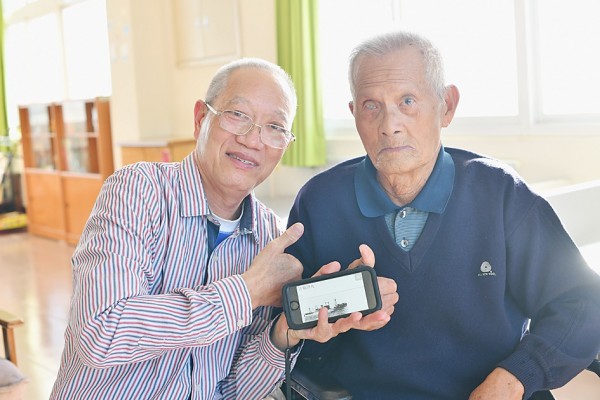《TAIPEI TIMES》 Japanese merchant marine veteran shares war stories

Historian Nien Chih-cheng, left, a Japanese merchant marine veteran, poses with Yang Tien-fu, 91, in Pingtung County on Wednesday. Photo: Tsai Tsung-hsien, Taipei Times
SURVIVOR: Yang Tien-fu survived the sinking of the ‘Osaka Maru’ and the bombing of the ‘Kibitsu Maru,’ and saw bodies after the torpedoing of the ‘Tamatsu Maru’
By Tsai Tsung-hsien and Jonathan Chin / Staff reporter, with staff writer
Pingtung County nonagenarian Yang Tien-fu (楊天富), a Japanese merchant marine veteran, is one of the last living witnesses to the sinking of the Japanese landing craft transport ship Tamatsu Maru during World War II.
The Tamatsu Maru was torpedoed and sank with the loss of 5,000 lives off the coast of the Philippines near Luzon on Aug. 19, 1944.
Historian Nien Chih-cheng (念吉成) said Yang’s story will be included in his latest book about the Pacific War, which has the tentatively titled of Tears of Bashi Channel (巴士海峽之淚).
Yang, 91, recently talked about some of his wartime experiences with the Chinese-language Liberty Times (the Taipei Times’ sister newspaper).
After graduating from a public high school in Checheng Township (車城) at 16, Yang said he took the entrance exam for a merchant marine engineer’s course in Kobe, Japan, without telling his family.
Having passed the exam, he entered the program in April 1943, and after graduation, he was assigned to the cargo ship Osaka Maru, which ran supplies to a Japanese garrison on Saipan Island.
“That was how I got into the Pacific War,” he said.
The Osaka Maru was torpedoed by Allied submarines on May 25, 1944; Yang made it onto a lifeboat with an experienced sailor, Masayuki Tanaka, and six Japanese servicemen.
Although the lifeboat had ample potable water and rations, the six servicemen succumbed to psychological distress and depression, and only Yang and Tanaka survived.
After being rescued, Yang and Tanaka were transported to Samal Island, where he was drafted into a “temporary enlistment” to help with Japanese defenses, he said.
After the island was blockaded by an Allied fleet, most of the food ran out, and the Japanese troops subsisted mainly on stockpiled soybeans and they had to evade Filipino guerrillas, he said.
His knowledge of how to cook green mangoes, green bananas and cassava helped him and many of his comrades survive until they were able to be evacuated to Japan, he said.
He was then assigned as an engineer to the Kibitsu Maru, a merchant ship that had been converted into a military transport bristling with anti-aircraft batteries.
The Kibtitsu Maru left the port of Moji in Kyushu in August 1944 and joined the Tamatsu Maru and other ships in a convoy carrying units of the elite Kwantung Army to the Philippines, he said.
After the flotilla reached the Bashi Channel, Allied submarines torpedoed the Tamatsu Maru and sank it, he said.
“The surface of the sea was covered with the corpses of my comrades. I saw Japanese soldiers holding their rifles shouting ‘Long live the emperor’ as they drowned. Korean soldiers shouted ‘eomeoni,’ their word for ‘mother.’ It was a terrible sight that I cannot forget,” he said.
The Kibitsu Maru was evacuating 500 sick or injured women of “special status” from Manila when it came under incessant air attacks on Aug. 7, 1945, that forced it to flee the Bashi Channel to Siaoliouciou Island (小琉球) off Pingtung.
The attacks were so intense that he was ordered to replace a wounded machine-gun loader and a blast blew his helmet off, he said.
“I took a cooking pot made of copper from the kitchen and put it on my head as a helmet. It was a dangerous battle,” he said.
Years later he ran into Hidetsugu Nakajima, a survivor of the Tamasui Maru, in Pingtung’s Hengchun Township (恆春), he said.
“We shared a very sad history,” he said.
新聞來源:TAIPEI TIMES



















